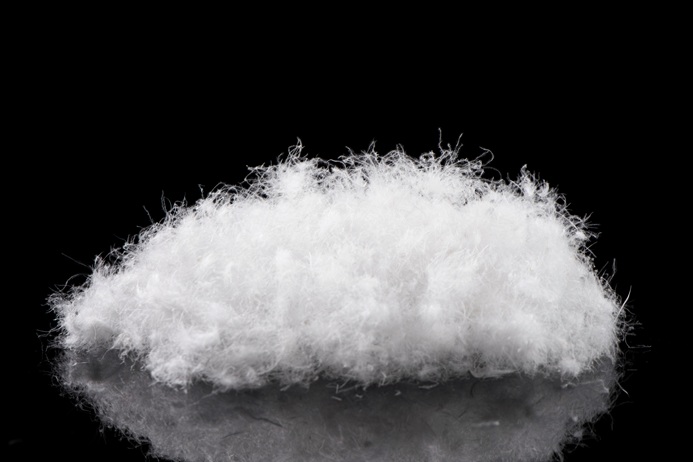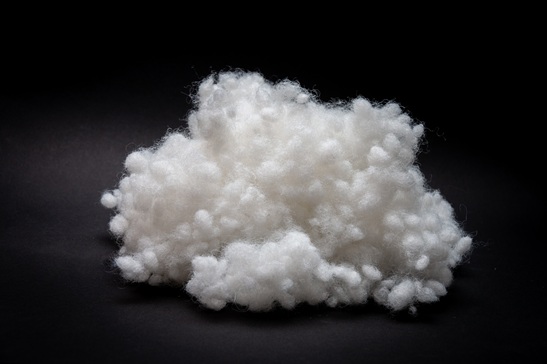Learn about Insulation for Backpacking Gear

Table of Contents
Down vs Synthetic Insulation
Warmth per Weight and Compressibility
Down is lighter and more compressible than synthetic insulation. Accordingly, down provides more warmth per weight and compressibility.
A down jacket will usually be warmer than a synthetic jacket of the same thickness. However, some high-end synthetic insulation is warmer than low fill-power down (fill power is described below). For example, Primaloft Gold synthetic insulation is warmer per volume (but not weight) than 550 fill-power down.1
Peformance When Wet
Insulation keeps you warm because it contains insulative dead air space when expanded to full volume. This fully expanded volume is called “loft.”
When down gets wet, it loses its loft and insulation ability.
Synthetic insulation maintains most of its loft when wet. For this reason, it’s often said to stay warm even when wet. However, it still loses insulation performance through conduction.
Overall, wet synthetic insulation is warmer than wet down. This might not be as important as you think. Down gear shouldn’t get wet, because you normally shouldn’t be hiking and sweating in it, and you shouldn’t be wearing it in the rain. You should be keeping it dry in a plastic bag or backpack liner, except when you’re wearing it while resting in cold, dry weather. If you use down properly, it’s usually the best choice for backpacking. However, synthetic insulation might be a better choice if you expect a lot of rain and humidity.
Durability
Down is much more durable than synthetic insulation. Unlike down, synthetic insulation loses insulating power each time it’s compressed.
Comparison of Down and Synthetic Insulation
| Down Insulation | Synthetic Insulation | |
|---|---|---|
| Performance When Wet | None | Some |
| Water Resistance | None | Water resistant |
| Weight | Extremely light | Heavier than down |
| Packability | Very compressible | Bulky |
| Durability | Can last 10+ years | Loses insulation performance after repeated compression |
| Price | Expensive | Affordable |
Down Insulation

Down-to-feather Ratio
Down is not the same as feathers. The latter have poor insulation performance. The most common down-to-feather ratios are 70/30, 80/20, and 90/10. The higher the down-to-feather ratio, the greater the warmth per weight and the higher the cost. Within your budget, aim for a high down-to-feather ratio.
Unfortunately, down-to-feather ratios aren’t always listed on products. Each company has its own method of measuring these ratios, and they can’t be compared reliably across brands.
Fill Power
Fill power is the volume of one ounce of down at maximum loft. The unit for fill power is in3/oz. For example, one ounce of 700 fill-power down occupies 700 cubic inches at maximum loft.
The higher the fill power, the greater the warmth and the higher the price. Within your budget, aim for high fill power. For budget backpacking, the sweet spot of price versus warmth/weight is usually 650 fill power. If the down is less than 550 fill power, synthetic insulation will probably be a better choice. If the down is higher than 650 fill power, it will probably be expensive. Try to find discount sales on 800 fill-power down with high fill weight (described below).
Fill-power testing is standardized, and fill powers can be compared across brands.
Fill Weight
Fill weight is simply the weight of a product’s down insulation. For equal fill powers, the higher the fill weight, the warmer (and heavier) the product.
Fill weight is just as important as fill power. An insulated jacket with high fill power won’t be warm if it has low fill weight. If you see a cheap jacket with high fill power, it probably has little insulation and won’t be very warm.
Fill Power vs Fill Weight
To compare the warmth of two down-insulated products with different fill powers and fill weights, multiply the fill power by the weight in ounces to get the loft volume, which determines the warmth.
Example:
| Fill power (in3/oz) | Fill weight (oz) | Calculation | Loft volume (in3) |
|---|---|---|---|
| 550 | 4 | 550 X 4 | 2200 |
| 700 | 2 | 700 X 2 | 1400 |
In the above example, the jacket with 550-fill power down will be warmer than the one with 700 fill-power down. It will also be heavier and cheaper. Remember, for backpacking, your concern is not only warmth but also warmth per weight. Decide what is best for you based on your budget and backpacking conditions.
Easy Comparison Of Warmth
Trying to compare the warmth of jackets based on down-to-feather ratio, fill power, and fill weight can be difficult. Ultimately, all these numbers boil down to thickness and weight. When comparing two jackets having the same down-to-feather ratio and fill power, the thicker one will usually be warmer. The one with the highest thickness-to-weight ratio will usually have the highest warmth-to-weight ratio.
Goose Down vs Duck Down
Goose down has higher fill power than duck down of the same grade. However, high-grade duck down can have higher fill power than low-grade goose down. Duck down is also cheaper. Overall, it usually won’t matter whether you buy goose down or duck down.
Hydrophobic Down
Hydrophobic down is treated with durable water repellent (DWR) to make it water-resistant. This allows it to dry faster and maintain its loft and insulation performance when wet. Hydrophobic down has the light weight of regular down plus the water resistance of synthetic insulation. However, even when wet synthetic or hydrophobic-down insulation maintains its loft, it still loses heat through conduction.
Although no scientific method exists for testing hydrophobic down in the field, it resists water very well in laboratory tests. However, the DWR deteriorates after washings, making the hydrophobic down lose its water resistance over time. In the long run, it’s questionable whether hydrophobic down is worth the extra cost.
Reputable brands of hydrophobic down:
- DriDown
- Nikwax Hydrophobic Down
- ULTRA-DRY Down
- DownTek
Synthetic Insulation

Synthetic Insulation Structures
For backpacking gear, synthetic insulation can have 3 structures:
- Short-staple
- Cluster fiber
- Continuous filament
Short-staple Fibers
A staple fiber is a textile fiber that has a discrete length. Short-staple fibers have a maximum length of 60 mm and are typically 1/4 to 1 inch long.2 3 4 They’re the least expensive and most commonly used fibers for insulation. Their short lengths allow them to move independently inside the clothing or sleeping bag, making it flexible.
Cluster Fibers
Cluster fibers are spun into small balls that mimic clusters of down. They’re the warmest synthetic insulation but also the most expensive.
Continuous Filaments
Continuous-filament insulation consists of a single, long fiber intertwined with itself.5 It’s stiff and durable and doesn’t move around inside the gear. It’s often used in sleeping bags.
Comparison of Short-staple, Cluster, and Continuous-filament Insulation
| Type | Warmth When Wet | Durability | Durability after repeated compressions | Flexibility | Weight | Cost | Examples |
|---|---|---|---|---|---|---|---|
| Short-staple | Good | Least durable | Poor | Flexible | Light | Most affordable | Thinsulate PrimaLoft Thermolite Microloft Columbia Omni-Heat Marmot Thermo-R |
| Cluster | Better | Somewhat durable | Good | Flexible | Light | Most expensive | North Face ThermoBall Patagonia Nano Puff Patagonia Micro Puff |
| Continuous filament | Best | Most durable | Best | Stiff | Heavy | Affordable | PolarGuard Arcteryx Coreloft |
Synthetic Insulation Performance
There is no fill-power test for synthetic insulation. Some companies list clo values (explained below) to indicate the warmth of their synthetic insulation, but these aren’t comparable with those of down or other brands of synthetic insulation. However, since warmth is largely determined by the volume of dead air space, a thick synthetic-fill jacket will usually be warmer (but not warmer per weight) than a thin down one.
Brands of Synthetic Insulation
Reputable brands of synthetic insulation with high warmth-to-weight ratios:
- PrimaLoft Gold
- Primaloft Silver
- Primaloft Black
- North Face ThermoBall
- Climashield
- Coreloft
- FullRange
- PlumaFill
- Helly Hanson LifaLoft
- Montbell Exceloft
Down-Synthetic Blends
Down-synthetic blends are a middle-of-the road option. They have the advantages and disadvantages of both insulation types, but to a lesser degree.
| Pros | Cons | |
|---|---|---|
| Down | Light (high warmth per weight) Compact (high warmth per compressed volume) Durable | Cold when wet Dries slowly Hard to wash Expensive |
| Hydrophobic down | Warmer than regular down when wet Dries faster than regular down Durable (except durability of water resistance) | Loses water resistance after washings Expensive |
| Synthetic | Warmer than down when wet Dries much faster than down Easy to wash Inexpensive | Heavy (low warmth per weight) Bulky (low warmth per compressed volume) Loses insulating power after compression |
| Down-synthetic blend | Partial advantages of both synthetic and down | Partial disadvantages of both synthetic and down |
Clo Value
Clo values measure warmth. One clo is the amount of insulation that allows a person at rest to maintain thermal equilibrium in an environment of 21°C (70°F), 0.1 m/s of air movement, and less than 50% humidity. For physics nerds, one clo equals 0.155 square-meter Kelvins per watt (0.155 K·m2·W−1).6,7,8
The clo value of no insulation, i.e., a naked body, is zero. At 1 clo, you should be comfortable at room temperature. Sub-zero temperatures may require layers adding up to 4 clo or higher.1,8,9,10,,11,12,13
Below are estimated clo values of one ounce of various kinds of insulation.
Clo/Oz/Yd2 of Various Kinds of Insulation1
| Insulation | Clo/oz/yd2 |
|---|---|
| 900 Fill-power Down | 2.53 |
| 800 Fill-power Down | 1.68 |
| 650 Fill-power Down | 1.00 |
| Primaloft Gold | 0.92 |
| Primaloft One | 0.92 |
| 550 Fill-power Down | 0.85 |
| Primaloft Black | 0.85 |
| ThermoPlume | 0.85 |
| ThermoBall | 0.85 |
| Coreloft | 0.82 |
| Climashield Apex | 0.82 |
| Primaloft Sport | 0.79 |
| Primaloft Silver | 0.79 |
| Primaloft Synergy | 0.79 |
| Climashield Prism | 0.76 |
| ThermaTek | 0.76 |
| Exceloft | 0.68 |
| Primaloft Eco | 0.68 |
| Primaloft Black | 0.65 |
Unfortunately, clo values aren’t usually listed on products. Different companies use different testing methods, so clo values can’t be compared reliably across brands.
